
Asclepias purpurascens, the purple milkweed, is a herbaceous plant species. It is in the genus Asclepias, making it a type of milkweed. It is native to the Eastern, Southern and Midwestern United States similar to the range of the common milkweed. The plant gets its name from the flowers that first develop a pink color but then turn darker purple as they mature. Unlike common milkweed, purple milkweed prefers some shade and is considered a plant of partial shade. It is also considered an indicator of oak savanna, especially in Wisconsin. The species rarely produces seed pods which are smooth, instead of the rough warty ones produced by common milkweed.

Viburnum nudum is a deciduous shrub in the genus Viburnum within the muskroot family, Adoxaceae.
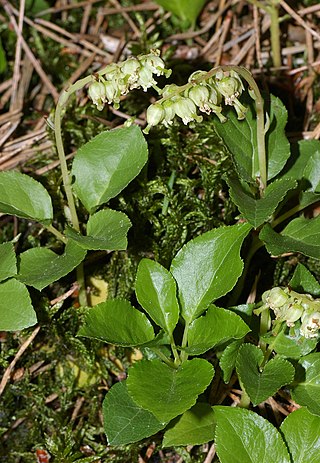
Orthilia is a genus of flowering plants in the family Ericaceae. It has only one species, Orthilia secunda. Its common names are sidebells wintergreen, one-sided-wintergreen and serrated-wintergreen. It is also called one-sided pyrola, one-sided shinleaf, and one-sided wintergreen. It was previously part of genus Pyrola, the wintergreens.
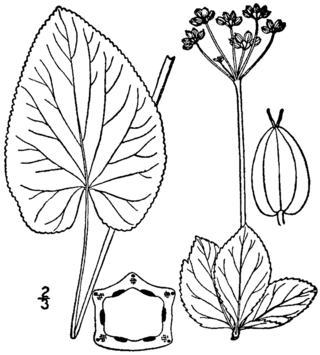
Zizia aptera is a flowering plant native to North America. Its common names include meadow zizia, golden alexanders, heart leaved golden alexanders, and prairie golden alexanders.
Chaetaglaea is a genus of moths of the family Noctuidae.
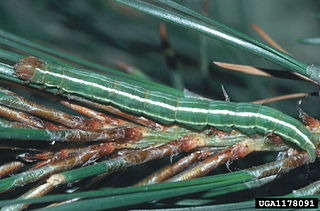
Zale curema, the black-eyed zale or northeastern pine zale, is a moth of the family Noctuidae. The species was first described by John Bernhard Smith in 1908. It is found from New York to Maine, south to western North Carolina, west to the Gulf States and Texas. The species is listed as endangered in Connecticut.
Arachnis nedyma is a moth of the family Erebidae. It was described by John G. Franclemont in 1966. It is found in the US states of New Mexico and Arizona.

Smilax tamnoides, common name bristly greenbrier, is a North American species of plants native to the United States and Canada. It is widespread from Ontario and New York State south to Texas and Florida.

Asclepias variegata, commonly called the redring milkweed or white milkweed, is a plant in the family Apocynaceae. It is native to eastern North America, where it is found in Canada and the United States. It is most common in the Southeastern United States, and becomes rare in the northern edge of its range.

Atriplex glabriuscula, common names Scotland orache, smooth orache, Babington's orache or seaside orach is an Atriplex species native to North America and northern Europe. It is an annual.
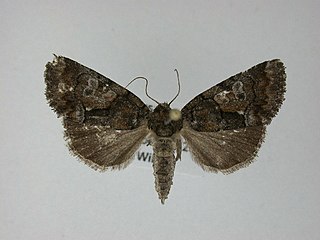
Chytonix sensilis, the barrens chytonix, is a species of moth of the family Noctuidae found in North America. It ranges from Quebec to Florida, and from Michigan to Texas. It was first described by Augustus Radcliffe Grote in 1881 and is now listed as endangered in the US state of Connecticut.
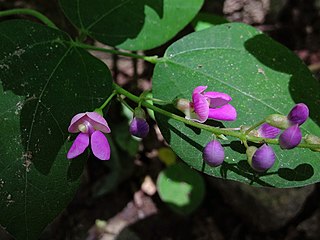
Phaseolus polystachios, also known as the thicket bean or wild kidney bean, is a perennial, herbaceous vine that is native to North America. It is unique among the Phaseolus in that its native range extends across the eastern temperate United States to southeast Canada, while most Phaseolus are tropical or subtropical. It is the namesake for the Polystachios group clade, which is the most species-rich within Phaseolus. In spite of its common name, it is more closely related to the lima bean, and it holds potential as a crop wild relative due to its resistance to white mold.
Crocanthemum dumosum, common known as bushy frostweed and bushy rockrose, is a perennial plant that is native to the United States.
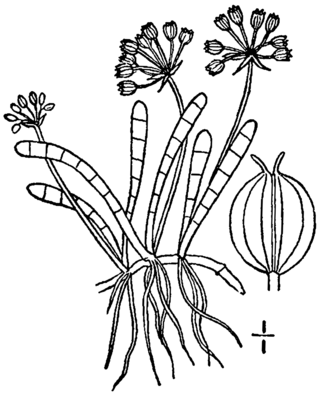
Lilaeopsis chinensis, common names eastern grasswort, eastern lilaeopsis, and lilaeopsis, is a plant that is native to North America.
Sympistis dentata, the toothed apharetra moth, is a moth of the family Noctuidae described by Augustus Radcliffe Grote in 1875. It is found from Yukon, the Northwest Territories, and British Columbia to Newfoundland and the northern United States, south in the east to New Jersey. It is listed as threatened in the US state of Connecticut.

Gamochaeta purpurea, the purple cudweed, purple everlasting, or spoonleaf purple everlasting, is a plant native to North America.

Glena cognataria, the blueberry gray moth, is a moth native to North America. It ranges from Florida to Nova Scotia and New Brunswick. Its larvae are hosted on blueberry. The habitat consists of bogs and pine barrens. It is listed as a species of special concern and believed extirpated in the US state of Connecticut.
Chaetaglaea fergusoni, or Ferguson's sallow moth, is a moth in the family Noctuidae. It was described by Vernon Antoine Brou Jr. in 1997 and is found in North America.

Onosmodium virginianum, common names gravel-weed, wild Job's tears, false gromwell, and Virginia false-gromwell is perennial plant native to the eastern United States.

Cuscuta coryli, synonym Grammica coryli, common name hazel dodder, is a perennial plant in the Cuscutaceae family native to North America.














